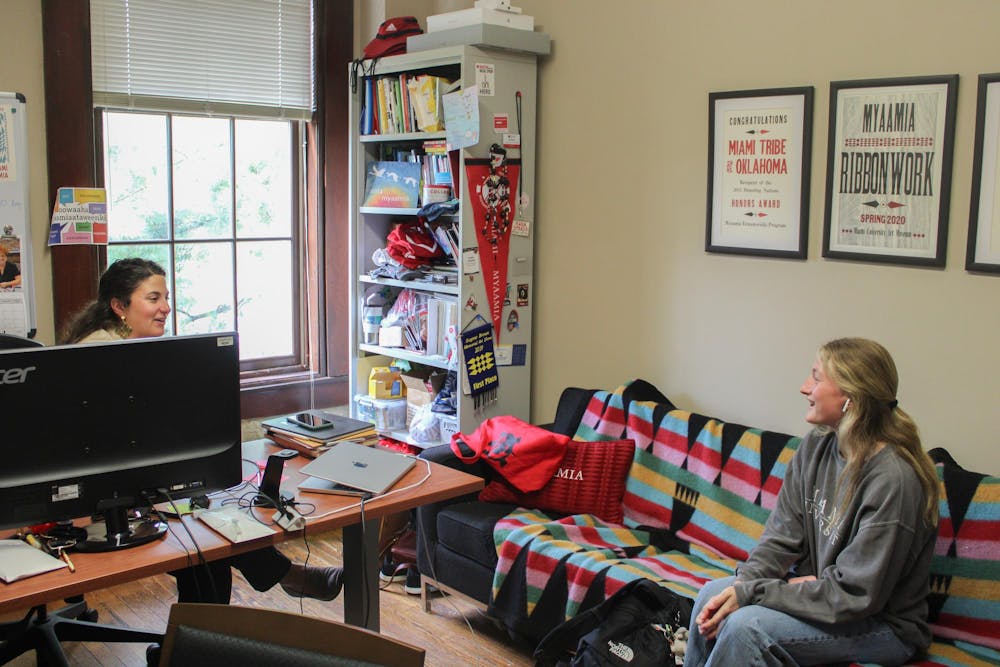The Myaamia people were forcibly removed from their traditional homelands and displaced to what is now known as Miami, Oklahoma. They are people of the present: living, working and studying across the country, all connected to each other.
Kristina Fox, Myaamia education coordinator for The Myaamia Center, said the Miami Tribe’s traditional homelands are what are known today as Indiana, Illinois, Western Ohio and parts of Wisconsin and Michigan. The tribe shared the area with several other tribes until the United States government developed a need for land.
“We started signing treaties, not always by choice,” Fox said. “There was definitely coercion happening, pressure from the U.S. to sign these treaties. The Treaty of Greenville, in 1795, is actually what ceded the land Miami University is on.”
According to the Miami Tribe of Oklahoma website, these treaty periods were devastating. In October of 1846, 500 of the Miami Tribe’s ancestors were walked at gunpoint to canal boats and steamboats that took them west near Kansas City, Missouri. They stayed there until the Treaty of 1867 called for their removal to the “Indian Territory,” now known as Oklahoma.
Kara Strass, director of Miami Tribe relations for the Myaamia Center, said the Miami Tribe is recognized as a sovereign nation by the U.S.
“You can think of tribes as having a similar level of power in the hierarchy of the United States as states," Strass said. “For example, if we are standing on the Miami reservation in Miami, Oklahoma, you do not have to follow state laws. You do have to follow federal laws.”
Enjoy what you're reading?
Signup for our newsletter
Fox said the tribe demonstrates their sovereignty through identification cards, elder benefits and their own police force.
She said it is also important to know where you came from and how you got to where you are, not just for Myaamia people, but for everyone.
“Knowing our history is important to stay connected to language and to family,” Fox said. “It’s such a big part of our community.”
Fox said they foster community with gatherings in summer and winter. The largest of the two is the National Gathering Week, which takes place in the summer. She said people come from every part of the country, taking time to connect through education, dancing and games. Official elections also take place during this gathering, where citizens elect five leaders, each with a three-year term. Positions include chief, second chief, secretary-treasurer, first councilperson and second councilperson.
She said there are also summer camps for citizens, ranging in age from babies to adults. It started in 2005, with 23 participants, and it has now grown to include five programs in two locations with 123 participants this past year.
Savannah Strack, a junior math and math education double major and a Miami Tribe citizen, said she never attended the summer camps when she was younger. She decided to help out at the camps her first year and brought her younger siblings to experience it for the first time.
“I fell in love with it,” Strack said. “I just felt so much closer to the language after [my first] year. I was the one teaching them, so I was also learning alongside them what the language was.”
Strack is in the Myaamia Heritage Award Program at Miami and said she loves attending heritage classes with her friends in the program. Each year, the subject they learn rotates between language and culture, history and ecology, contemporary issues and sovereignty and a senior project in their last year.
Strass said the relationship between the Miami Tribe and Miami University was formed by individual people connecting with each other. She said in the 1990s, Chief Floyd Leonard and Myrtis Powell, former vice president of student affairs, connected on ways to institutionalize their relationship with a focus on education.
She said in 2001, Daryl Baldwin arrived as the first director of the Myaamia project and started the conversations about revitalization that have impacted the relationship between the Miami Tribe and the university since then.
“Today, we have 46 students enrolled at Miami University and 135 graduates of this program,” Strass said. “For a community like ours, that's quite small – about 7,000 tribal citizens – this is having a really big impact on what the tribe can accomplish through language and cultural revitalization.”




